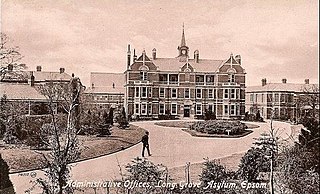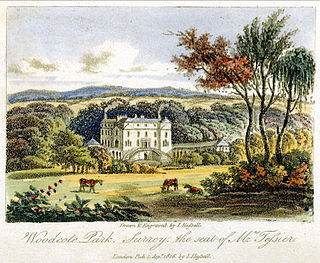
Epsom is a town in the borough of Epsom and Ewell in Surrey, England, about 14 miles south of central London. The town is first recorded as Ebesham in the 10th century and its name probably derives from that of a Saxon landowner. The earliest evidence of human activity is from the mid-Bronze Age, but the modern settlement probably grew up in the area surrounding St Martin's Church in the 6th or 7th centuries and the street pattern is thought to have become established in the Middle Ages. Today the High Street is dominated by the clock tower, which was erected in 1847–8.

Epsom and Ewell is a local government district with borough status in Surrey, England, covering the towns of Epsom and Ewell. The borough lies just outside the administrative boundary of Greater London, but it is entirely within the M25 motorway which encircles London. Many of the borough's urban areas form part of the wider Greater London Built-up Area.

Banstead is a town in the borough of Reigate and Banstead in Surrey, England. It is 3 miles (5 km) south of Sutton, 5 miles (8 km) south-west of Croydon, 8 miles (13 km) south-east of Kingston-upon-Thames, and 13 miles (21 km) south of Central London.

Friern Hospital was a psychiatric hospital in the parish of Friern Barnet close to a crossroads which had a hamlet known as Colney Hatch. In 1965, it became part of the London Borough of Barnet and in the early 21st century was converted to residential housing as Princess Park Manor and Friern Village. The hospital was built as the Second Middlesex County Asylum and was in operation from 1851 to 1993. After the County of London was created in 1889 it continued to serve much of Middlesex and of the newer county, London. During much of this time its smaller prototype Hanwell Asylum also operated.

Long Grove Hospital, formerly Long Grove Asylum, was a mental hospital, part of the Epsom Cluster of hospitals in the Horton area of Epsom, Surrey in the United Kingdom.
Horton is a village in the borough of Epsom and Ewell, in the county of Surrey, England. It is situated between the towns and villages of Epsom, West Ewell, Chessington and Malden Rushett. Its principal road is Horton Lane, which runs the length of the area between West Ewell and Epsom Common. Horton Country Park also runs along the length of the area, between Epsom Common and West Ewell.
The Horton Light Railway had its origins in a contractor's line built in 1905 to transport building materials, coal and other supplies for London County Council's Epsom Cluster of psychiatric hospitals in the Horton area to the North-West of the town of Epsom. The Light Railway Order did not permit the carriage of passengers. The railway connected with the mainline network just south of Ewell West railway station.

Horton Country Park is a 152.3-hectare (376-acre) Local Nature Reserve north-west of Epsom in Surrey. It is owned and managed by Epsom and Ewell Borough Council.
The Commissioners in Lunacy or Lunacy Commission were a public body established by the Lunacy Act 1845 to oversee asylums and the welfare of mentally ill people in England and Wales. It succeeded the Metropolitan Commissioners in Lunacy.

The Hellingly Hospital Railway was a light railway owned and operated by East Sussex County Council, used for transporting coal and passengers to Hellingly Hospital, a psychiatric hospital near Hailsham, from the London, Brighton and South Coast Railway's Cuckoo Line at Hellingly railway station.

Netherne-on-the-Hill is a village in Surrey, England, occupying a plateau once home to Netherne Hospital. The village is across a narrow valley from Hooley in north of the borough of Reigate and Banstead; through the valley runs the Hooley Tunnel cutting and A23, the only road from which the village can be accessed, from two designated side roads; a few metres south of the southern T-junction, the road divides into two grades: the A23 to Redhill, 3 miles (4.8 km) south, and the M23 motorway which has a junction with the M25 motorway within Merstham's boundaries, the former village of the hilltop land. The post town, Coulsdon in Greater London is centred 1.8 miles (2.9 km) due north.

West Park Hospital was a large psychiatric hospital in Epsom, Surrey.

Springfield University Hospital is a psychiatric hospital in Tooting, South London and also the headquarters of the South West London and St George's Mental Health NHS Trust.

Woodcote Park is a Grade II* listed stately home and estate of about 350 acres near Epsom, Surrey, England, currently owned by the Royal Automobile Club. It was formerly the seat of a number of prominent English families, including the Calvert family, Barons Baltimore and Lords Proprietor of the colony of Maryland. The interior of the house once boasted a gilded library and number of fine murals by notable Italian artists including Antonio Verrio, but most of the historic rooms were removed by the RAC, which had purchased the estate in 1913, and what remained was destroyed by fire in 1934. The present appearance of the house dates from its restoration in 1936. However, the interior of one of the original drawing rooms still survives in the Museum of Fine Arts at Boston, Massachusetts. The estate was used by the military as a convalescent hospital in the First World War and as a training camp in both world wars.

Horton Hospital, formerly called Horton Asylum, was a large psychiatric hospital in the Horton area of Epsom, Surrey.

St Ebba's Hospital formerly Ewell Epileptic Colony (1904–1918) and later Ewell Mental Hospital (1927–1938) is a mental handicap and former psychiatric hospital near Epsom in the county of Surrey, England.

The Manor Hospital, formerly The Manor Asylum and The Manor Certified Institution was a mental handicap and psychiatric hospital in Horton, near Epsom, Surrey, United Kingdom

Netherne Hospital, formerly The Surrey County Asylum at Netherne or Netherne Asylum was a psychiatric hospital in Hooley, Surrey in the United Kingdom.

The Old Manor Hospital was a psychiatric hospital in Salisbury, Wiltshire, England. It was established in the early 19th century as a private licensed house called Fisherton House or Fisherton House Asylum, which became the largest private madhouse in the United Kingdom. In 1924, following a change of proprietors, it was renamed Old Manor Hospital and in 1955 it was amalgamated into the National Health Service. From 1813 to 1955 it was owned and managed by members of the same family. The Old Manor Hospital closed in 2003 and was replaced by Fountain Way, a smaller, modern, psychiatric hospital on part of the same site. In 2014 the site was acquired by Quantum Group for development as a residential estate and the conversion of the main building to a hotel.

Botleys Mansion is a Palladian mansion house in the south of Chertsey, Surrey, England, just south of St Peter's Hospital. The house was built in the 1760s by builders funded by Joseph Mawbey and to designs by Kenton Couse. The elevated site once bore a 14th-century manor house seized along with all the other manors of Chertsey from Chertsey Abbey, a very rich abbey, under Henry VIII's Dissolution of the Monasteries and today much of its land is owned by two hospitals, one public, one private, and the local council authority. The remaining mansion and the near park surrounding were used for some decades as a colony hospital and as a private care home. The building is owned and used by a wedding venues company.



















